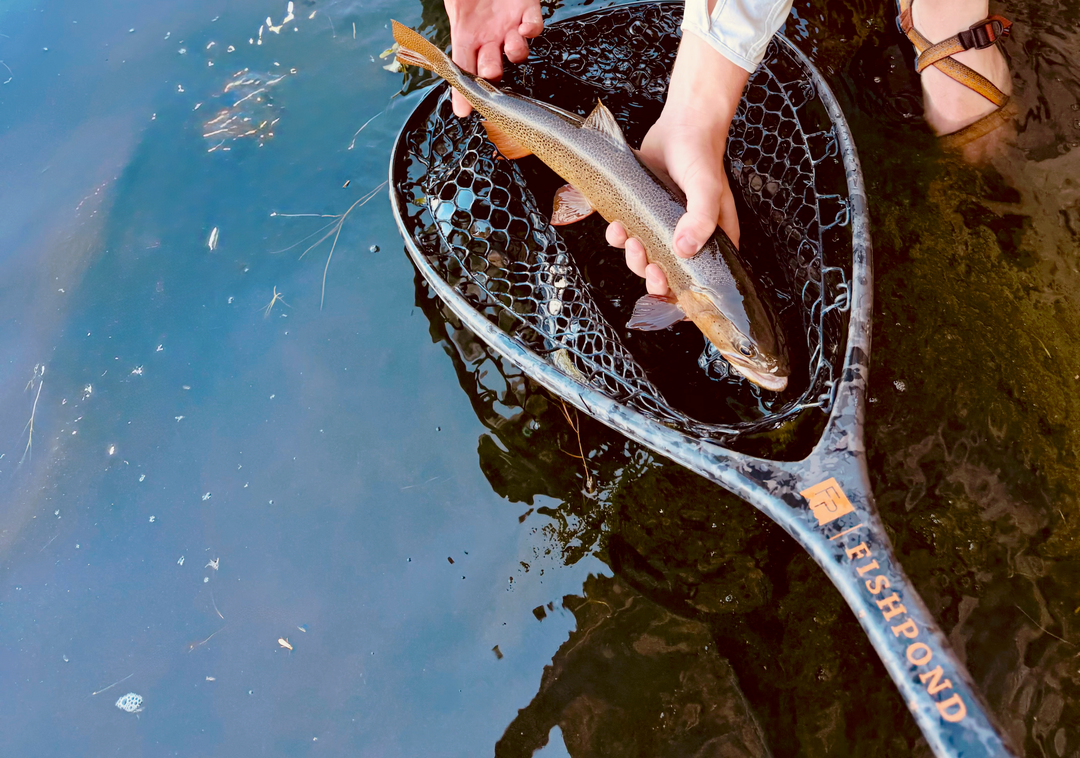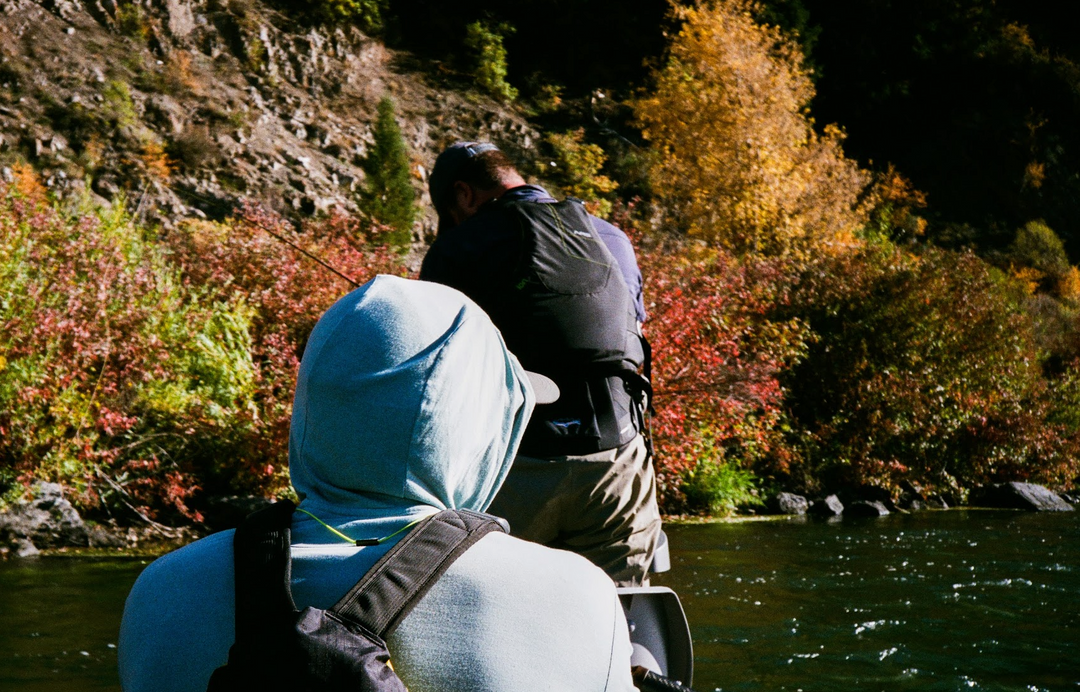How Fly Tying Makes You a Better Angler

Fly fishing is a sport where curiosity pays off. It’s dynamic, complex, and full of nuance—just when you think you’ve figured it out, the river throws something new at you. Once you think you've master trout fishing you go on your first salmon trip and you don't see the same level of success - the natural learning cycle starts all over again.
You can always upgrade your rod, buy the latest gear, or invest in a boat, and those things can certainly enhance your experience. But if you’re looking to genuinely grow as an angler, few things accelerate your learning curve like tying your own flies.
Fly tying isn’t just about crafting something that catches fish—it’s about engaging more deeply with the sport. It forces you to think like a trout, understand aquatic ecosystems, and connect what you’re doing at the vise with what’s happening in the water. This blog explores how fly tying becomes a gateway to continuous learning, making you not just more prepared, but more effective on the water.
The Educational Value of Fly Tying
Understanding Insect Life Cycles
Fly tying inherently involves studying the life cycles of aquatic insects, which are a primary food source for many fish, especially trout. By creating dry flies, nymphs, and streamers that imitate various stages of insect development, fly fishermen deepen their understanding of a trout’s food options and feeding behavior.
Understanding the timing and nature of a hatch—when nymphs or larvae transition to adults—helps anglers select the most effective fly patterns to match what trout are feeding on during these key periods and put a bend in that rod tip.
For instance, tying a mayfly emerger with a foam head versus a weighted fly with a heavy bead helps anglers match the hatch more effectively. This ability to select the right fly during a hatch—whether you're looking for a natural drift from a high floating Griffiths Gnat in winter or nymphing an egg pattern 10 feet deep subsurface—improves the chances to catch fish, especially during these iconic surface strike windows in dry fly fishing.
Aquatic Entomology and Ecosystem Awareness
Engaging in fly tying turns anglers into amateur entomologists. Crafting nymphs, streamers, or dry flies means replicating minute details of insects like stoneflies, caddisflies, and midges using feathers, dubbing, and wire. Anglers learn what patterns work best in shallow water, deeper water, or slow, slower water, depending on the hatch and how fish sit and feed.
Recognizing which insects are present in different locations and seasons can also indicate water health, weather trends, and future hatches—knowledge that gives anglers an edge when deciding where and how to fish.
Developing Practical Skills Through Fly Tying

This nice rainbow ate a Bionic Ant (my favorite terrestrial pattern) that I tied. The original Bionic Ant was tied with coachman brown hackle and brown wing, but I had a hard time seeing the fly so I started tying them with a white wing and grizzly hackle instead which allowed me to see the fly more easily in a variety of lighting conditions. That wasn't an option in the commercially tied flies so the only way to get that change was to tie them myself.
Fly tying isn’t just a creative outlet—it’s a hands-on way to level up your fishing. Every thread wrap, material choice, and new pattern you try builds a deeper understanding of how flies work and why fish respond to them. It starts at the vise, but the real magic happens when you take those flies to the water. You observe how they behave, tweak what’s off, and learn from what works—and what doesn’t. That process builds practical, transferable skills that make you a more capable, confident angler.
Mastering Materials and Techniques at the Bench
The learning curve with fly tying begins with materials. Over time, you learn how to select the right ones—not just for looks, but for performance. A heavier tungsten bead sinks faster and gets you into the strike zone quicker. CDC and deer hair keep your dries riding high, even in slow water where trout get picky. You start to understand how dubbing, wire, and hackle all contribute to the way a fly swims, sinks, or floats—and how to use them to your advantage.
This technical understanding makes your flies more effective, but it also gives you insight into what the fish might need that day. Whether it’s adjusting weight, hook size, or body profile, every decision you make at the bench sets you up to fish smarter once you're on the water.
Field Testing and Observation
Flies don’t earn their place in your box until they prove themselves on the water. And once you’ve tied it yourself, you start watching more closely: Does that nymph fall too fast in slower water? Is your dry getting dragged because of tippet size or a poor drift? Those little moments of observation are powerful—they turn casual fishing into active learning helping put a tight line on your rod more than it has in the past.
You begin to analyze each outing. Instead of shrugging off a slow day, you ask better questions: Should I have used a slimmer silhouette? Did I need a lighter bead? Was I fishing too shallow? This kind of reflection tends to tightens the feedback loop between tying and fishing. Every trip teaches you something new, and every adjustment makes you sharper and increasing the depth of your bag of tricks.
Even when the fishing’s slow, it’s still a win—because you’re gaining knowledge that helps you make better decisions the next time your in fast moving water or on your local lake. And let’s face it: even a day of “testing flies” beats most other ways you could spend your time.
Mistakes That Make You Better
Every fly tier has tied something that looked good in the vise but failed in the field. And that’s okay—it’s part of the process. Maybe your proportions are off and the fly doesn’t sit right. Maybe your whip finish comes undone mid-cast. Or maybe your fly just doesn’t get noticed, no matter how good you thought it looked. A lot of flies "catch" humans and not fish.
Those “failures” are actually some of your most valuable lessons.
I used to tie and throw big articulated streamers because they looked so life like in the water and moved a ton of water—but they didn’t always work on the smaller rivers I fish. Then after talking with Umpqua Signature tier Lance Egan talk about scaling down, and everything changed. Switching to slightly smaller, more controlled streamers helped me hook more trout, more often.
So don’t sweat the bad ties. Take notes, watch your flies in action, and keep pushing yourself to try new things. Over time, those small lessons stack up—and they don’t just make you a better tier. They make you a better angler that has a lot more control in their angling success than you may currently think.
Better Fly Selection Through Tying: Matching Patterns to Conditions

My attractor style pattern nymph box that tend to be a lot of my go-to flies that cover a decent spread of imitations.
One of the biggest advantages of tying your own flies is how it sharpens your understanding of fly selection—arguably one of the more critical skills in fly fishing. When you tie your own flies, you're not just picking patterns from a fly shop wall; you're learning to think like a trout, a nymph drifting to the service to hatch, and an angler all at once.
Tying teaches you the subtle differences between fly types—how variations in weight, size, color, or profile affect how a fly behaves in the water. That knowledge becomes invaluable on the river. When conditions change—say, fish are feeding deep in cold, clear water—you’ll know a bead head nymph with a slim profile might sink faster and more naturally than a bushy commercial pattern. When trout are rising to a thick hatch, you can reach into your box and pull out a fly that doesn’t just look right—it is right, because you tied it to match that exact hatch.
Fly tying also makes you more observant. You start to notice the color of a mayfly’s body, the way caddis wings sit on the surface, or how sculpin dart near the bottom. These details influence what you tie and, in turn, what you fish. You’re not guessing anymore—you’re matching real food sources with precision and purpose.
And when it comes to different species, tying gives you the flexibility to adapt. Need a slightly flashier streamer for aggressive fall browns? Or a smaller emerger for spooky spring creek rainbows? You can tie exactly what you need, instead of settling for whatever’s available.
In short, tying makes fly selection less about trial-and-error and more about informed decision-making. It helps you fish with intention—and that’s often what turns a few strikes into a great day on the water.

That same nymph box makes a great plate for lunch. An almost $1,000 plate, but a plate none the less!
Fly Tying Builds Better Anglers—Together
Fly tying doesn’t happen in a vacuum—and that’s one of its biggest strengths. It naturally brings anglers together, creating a space to share knowledge, trade ideas, and push each other to improve. Whether you’re at a local tying night, chatting in an online forum, or tossing a couple of your go-to flies to someone you just met on the river, every interaction adds to your growth.
Being part of the fly tying community means learning from others and sharing what you’ve discovered along the way. From beginner bugs to dialed-in techniques that take seasons to perfect, everything shared helps someone else become a better angler—and that includes you. Every tip, technique, or story swapped is another step toward deeper understanding, better decisions on the water, and more fish in the net.
In the end, fly tying doesn’t just build community—it builds better anglers through that community.
The Calm and Creativity Behind the Vise
Fly tying isn’t just about catching fish—it’s also about what it does for you personally. There’s something deeply calming about sitting down at the vise, tuning out the world for a bit, and getting lost in the rhythm of tying. It’s a chance to slow down, clear your head, and focus entirely on the task in front of you. In a fast-paced, constantly connected world, that kind of mental reset can be a rejuvenating.
At the same time, fly tying is an outlet for creativity. You get to design something with your own two hands—experiment with colors, shapes, and styles—and then see how it performs out on the water. Every fly is a little reflection of your imagination, and there’s real satisfaction in building something from scratch that might just fool a fish.
Whether you’re tying before a big trip or just to unwind after a long day, it’s more than a hobby—it’s a way to recharge, express yourself, and stay connected to the part of fly fishing that goes beyond catching.
Why Fly Tying Makes You a Better Angler

This trout slider has become one of my favorite streamer patterns. It's what I caught my largest brown trout on last year which you can read about here. I used this pattern on that day because it rides hook side up, has reasonable weight and allowed me to jig strip it through shallower riffles where we had hooked several other fish earlier in the evening. By using a streamer that rides hook side up we snagged less allows us to fish more often without issues.
At its core, fly tying isn’t just about making flies—it’s about becoming a more thoughtful, skilled, and adaptable angler. The process sharpens your understanding of what fish eat, how they behave, and how conditions change day to day. It pushes you to observe more closely, think more critically, and experiment with purpose. Over time, tying your own flies makes you more in tune with the water, more confident in your decisions, and ultimately more effective at landing quantity and quality trout. It's not just a side hobby—it’s one of the most valuable tools you can have in your fly fishing journey.




